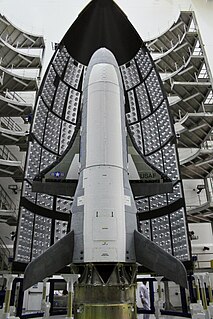Related Research Articles

The Boeing X-37, also known as the Orbital Test Vehicle (OTV), is a reusable robotic spacecraft. It is boosted into space by a launch vehicle, then re-enters Earth's atmosphere and lands as a spaceplane. The X-37 is operated by the United States Space Force, and was previously operated by Air Force Space Command until 2019 for orbital spaceflight missions intended to demonstrate reusable space technologies. It is a 120-percent-scaled derivative of the earlier Boeing X-40. The X-37 began as a NASA project in 1999, before being transferred to the United States Department of Defense in 2004.
Andrews Space was founded in 1999 by Jason Andrews and Marian Joh to be a catalyst in the commercialization, exploration and development of space. Originally named Andrews Space & Technology, the company shortened its name in 2003 to Andrews Space. Over its life the company developed many unique technologies and space transportation architectures for the US Government and commercial customers. The company is now Spaceflight Systems, a subsidiary of Spaceflight Industries, Inc.

USA-212 was the first flight of the Boeing X-37B Orbital Test Vehicle 1, an American robotic vertical-takeoff, horizontal-landing (VTHL) spaceplane. It was launched aboard an Atlas V rocket from Cape Canaveral on 22 April 2010, and operated in low Earth orbit. Its designation is part of the USA series.

USA-226 is the first flight of the second Boeing X-37B, the Orbital Test Vehicle 2, an American unmanned robotic vertical-takeoff, horizontal-landing spaceplane. It was launched aboard an Atlas V rocket from Cape Canaveral on 5 March 2011, and landed at Vandenberg Air Force Base on 16 June 2012. It operated in low Earth orbit. Its mission designation is part of the USA series.
The Rocket City Space Pioneers (RCSP) was one of 29 teams from 17 different countries officially registered and in the competition for the Google Lunar X PRIZE (GLXP) during 2010–2012.

A space tug is a type of spacecraft used to transfer spaceborne cargo from one orbit to another orbit with different energy characteristics. An example would be moving a spacecraft from a low Earth orbit (LEO) to a higher-energy orbit like a geostationary transfer orbit, a lunar transfer, or an escape trajectory.
The EELV Secondary Payload Adapter (ESPA) is an adapter for launching secondary payloads on orbital launch vehicles.
Secondary payload, also known as rideshare payload, is a smaller-sized payload transported to orbit on a launch vehicle that is mostly paid for—and with the date and time of launch and the orbital trajectory determined—by the entity that contracts and pays for the primary launch. As a result, the secondary payload typically obtains a substantially reduced price for transportation services to orbit, by accepting a trade off of the loss of control once the contract is signed and the payload is delivered to the launch vehicle supplier for integration to the launch vehicle. These tradeoffs typically include having little or no control over the launch date/time, the final orbital parameters, or the ability to halt the launch and remove the payload should a payload failure occur during ground processing prior to launch, as the primary payload typically purchases all of these launch property rights via contract with the launch services provider.
Spaceflight Industries, Inc. is an American private aerospace company based out of Herndon, Virginia that specializes in geospatial intelligence services. It sold its satellite rideshare business, Spaceflight, Inc., in June 2020.
Tyvak Nano-Satellite Systems designs, builds and provides nanosatellite and CubeSat space vehicle products and services for government and commercial customers. Tyvak is based in Irvine, California. It is a subsidiary of Terran Orbital Corporation.

A small-lift launch vehicle is a rocket orbital launch vehicle that is capable of lifting up to 2,000 kg (4,400 lb) or up to 5,000 kilograms (11,000 lb) of payload into low Earth orbit (LEO). The next larger category consists of medium-lift launch vehicles.
Satellogic is an Argentine company specialized in Earth-observation satellites, founded in 2010 by Emiliano Kargieman and Gerardo Richarte. Satellogic made Argentina's first two nanosatelites, CubeBug-1 and CubeBug-2. Their third satellite, BugSat 1, launched in June 2014. Both the CubeBug-1 and CubeBug-2 as well as the BugSat 1 satellite served as technology tests and demonstrations for the ÑuSat satellites. They also had amateur radio payloads.
SHERPA is a commercial satellite dispenser developed by Andrews Space, a subsidiary of Spaceflight Industries, and was unveiled in 2012. The maiden flight was on 3 December 2018 on a Falcon 9 Block 5 rocket, and it consisted of two separate unpropelled variants of the dispenser.

Capella Space is an American space company. It is developing space-based radar Earth observation satellites equipped with synthetic-aperture radar that can penetrate clouds and work at night. The company is based in San Francisco, California, and it was founded by Payam Banazadeh, a former engineer at Jet Propulsion Laboratory of NASA, and William Walter Woods.
Jason Andrews is an American space and technology entrepreneur. He co-founded with his wife Marian Joh, Andrews Space in 1999, founded Spaceflight Inc. in 2010, BlackSky Global LLC in 2013, and integrated all three entities together in 2015 under Spaceflight Industries.

Nova-C is a lunar lander designed by the private company Intuitive Machines to deliver small commercial payloads to the surface of the Moon.

USA-261, also referred to as Orbital Test Vehicle 4 (OTV-4) or AFSPC-5, is the second flight of the second Boeing X-37B, an American unmanned vertical-takeoff, horizontal-landing spaceplane. It was launched to low Earth orbit aboard an Atlas V rocket from Cape Canaveral on May 20, 2015. Its mission designation is part of the USA series.
USA-299, also referred to as Orbital Test Vehicle 6 (OTV-6), is the third flight of the first Boeing X-37B, an American unmanned vertical-takeoff, horizontal-landing spaceplane. It was launched to low Earth orbit aboard an Atlas V launch vehicle from SLC-41 on 17 May 2020 and remains in orbit. Its mission designation is part of the USA series.
A satellite dispenser is a space tug usually released from the upper stage of a rocket and designed to fly small secondary payloads to their desired location before deploying them.
References
- ↑ "Spaceflight - About".
- 1 2 "Spaceflight Industries, Inc. Completes Sale of Rideshare Business" (Press release). Herndon, Virginia. Businesswire. 12 June 2020. Retrieved 18 July 2020.
- 1 2 3 "Company Experience". Archived from the original on 15 January 2013. Retrieved 7 October 2013.
- ↑ Messier, Doug (3 June 2015). "Spaceflight Integrates 3 Service Lines in New Website – Parabolic Arc" . Retrieved 18 July 2020.
- ↑ "Spaceflight Inc. to Fly Payloads on LauncherOne". 20 July 2012. Retrieved 7 October 2013.
- ↑ "Spaceflight Inc. Tapped To Find Rides for STP Satellite". Space News, 30 April 2012.
- ↑ "Spaceflight Inc. and SpaceX Sign Secondary Payload Deal". SpaceRef. 11 June 2012. Retrieved 7 October 2013.
- ↑ "Spaceflight Completes SHERPA Design Review, Announces Hosted Payload Opportunities". Parabolic Arc. 7 August 2013. Retrieved 7 October 2013.
- ↑ Rosenberg, Zach. "Spaceflight Inc unveils the Sherpa in-space tug" FlightGlobal, 7 May 2012
- ↑ "Spaceflight - Mission Management, Including Licensing and Integration". Spaceflight. Retrieved 2020-12-22.
- ↑ Datta, Anusuya (2020-12-14). "Spaceflight to launch its first next-gen orbital transfer vehicle in January now". Geospatial World. Retrieved 2020-12-22.